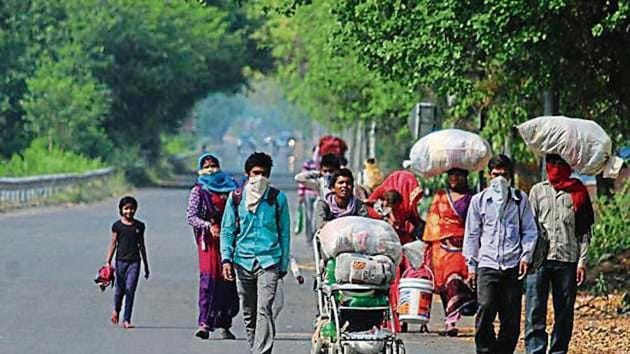Migrant crisis may hurt incomes in poorer states
On March 11, the World Health Organization declared the Covid-19 outbreak a pandemic. With effect from March 25, India announced a nationwide lockdown.
What will be the Covid-19 pandemic’s impact on India? The Reserve Bank of India expects the Indian economy to contract this financial year. But given the recent release of gross domestic product (GDP) numbers for the quarter ended March , a big-picture analysis may be needed. In a three-part data journalism series, of which this is the second part, HT attempts to do exactly that. The first part, published on June 6, looked at the economic situation before the pandemic. The second part will look at the immediate effects of the crisis and their macroeconomic consequences. The third part will argue that the existing policy response may not go far enough.

On March 11, the World Health Organization declared the Covid-19 outbreak a pandemic. With effect from March 25, India announced a nationwide lockdown. This was among the most stringent in the world. A database compiled by Oxford University has ranked countries in a stringency index. The more severe the lockdown, the higher the stringency index score. Data shows that among the top five countries by GDP ( the US, China, Japan, Germany and India ), only India scored the maximum 100 for almost a month. To be sure, restrictions have been eased in the past month, and the country is now emerging out of the lockdown. (See Chart 1)

As had been expected, economic activity has suffered heavily. The only high frequency indicators which are available for the period after the lockdown are the Purchasing Managers’ Indices (PMI). Both the manufacturing and services indices crashed to their lowest-ever values, 27.4 and 5.4, respectively in April. They have increased to 30.8 and 12.6 for May, but continue to signify massive contraction in economic activity. PMI indices signify expansion when they are above 50. The GDP data for the quarter ending June 2020 will only be available in August. Lockdown related restrictions are also likely to hinder data collection efforts. For example, the National Statistical Office (NSO) was unable to properly collect inflation data in April.
Coronavirus outbreak: Full coverage
These statistical difficulties notwithstanding, it is possible to lay down some general principles. Among the most visible economic impacts of the lockdown has been a massive reverse migration of workers to villages. The actual estimates of such migration by reputed scholars vary from 5 million by Nomman Majid of the International Labour Organisation to as much as 30 million by Chinmay Tumbe of the Indian Institute of Management-Ahmedabad.
Anecdotal evidence suggests that the number is likely to be far more than 5 million. For example, the Uttar Pradesh government alone was looking at expanding daily employment under the Mahatma Gandhi National Rural Employment Guarantee Scheme by 3 million in March.
The humanitarian aspect of the reverse migration has caught everybody’s imagination. But its economic impact is equally important. Migrants have an important role in India’s economy.
An example from a unique multigenerational research project in an Indian village can help us understand this. Palanpur in Moradabad district of Uttar Pradesh has been studied by many economists since 1974-75. In their 2018 book on the Palanpur surveys, as they are referred to by economists, Himanshu, Peter Lanjouw and Nicholas Stern give accounts of six such surveys between 1957-58 and 2015.
In 1957-58 less than 40% of non-farm jobs were located outside the village. This number increased to 84% and 76% in 1974-75 and 1983-84. It subsequently dipped and was around the 60% mark in 2015. The share of non-cultivation incomes has continuously increased during this period. It was 22% in 1957-58 and increased to 60% in 2008-09, the latest period for which data is available. Of the non-farm jobs located outside the village, 60% were located at least 50 kilometers away in 2008-09.
Reverse migration also entails loss of income for migrant workers. This can be very significant for poorer states. A 2018 World Bank paper by Gaurav Nayyar and Kyoung Yang Kim found that migrant remittances had a share of 35% in Bihar’s gross state domestic product (GSDP) and positively affected consumption at the household level. Any severe disruption of these remittances, which is what the lockdown must have inflicted, can result in a massive income shock in poor states.
India’s workforce was already under distress even before the pandemic. The unemployment rate, according to the 2017-18 Periodic Labour Force Survey, was 6.1%, the highest in four decades. Real rural wages declined continuously between September 2019 and January 2020, the latest period for which data is available. (See Chart 2)

The sudden exodus of migrants who have returned to their villages from the cities will push wages down even more. This will further squeeze earnings and subsequently demand. Weakness in demand may generate additional headwinds for revival of economic activity even in urban areas. According to the 2011-12 Consumption Expenditure Survey (CES), rural areas have a bigger share of total consumption expenditure in India. Per capita consumption was almost double in urban areas, but with the much bigger population share, the share of rural areas in total consumption was greater. Rural India must have lost some of its population advantage between 2011-12 and 2020. However, it is unlikely that the rural share of consumption will be insignificant.
Obviously, this is not the only economic disruption due to the pandemic. Economic activities that cannot ensure physical distancing will have to wait for revival. The resolution of this, however, will largely depend on medicinal advances vis-a-vis Covid-19. There is little scope for policy intervention on this count.
Get World Cup ready with Crickit! From live scores to match stats, catch all the action here. Explore now!
See moreGet Current Updates on India News, Budget 2024, Weather Today along with Latest News and Top Headlines from India and around the world.



